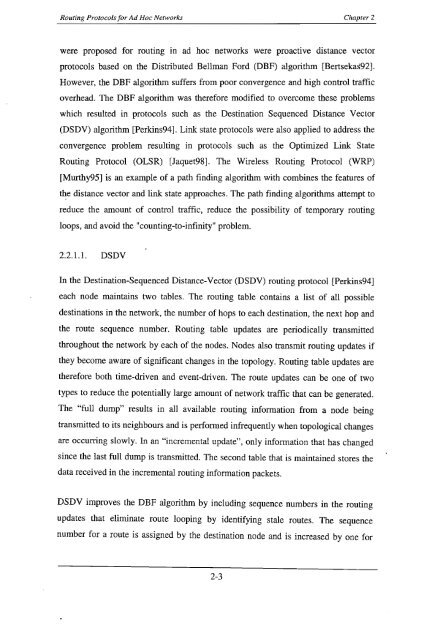Gugrajah_Yuvaan_ Ramesh_2003.pdf
Gugrajah_Yuvaan_ Ramesh_2003.pdf
Gugrajah_Yuvaan_ Ramesh_2003.pdf
You also want an ePaper? Increase the reach of your titles
YUMPU automatically turns print PDFs into web optimized ePapers that Google loves.
Routing Protocols for Ad Hoc Networks Chapter 2<br />
were proposed for routing in ad hoc networks were proactive distance vector<br />
protocols based on the Distributed Bellman Ford (DBF) algorithm [Bertsekas92].<br />
However, the DBF algorithm suffers from poor convergence and high control traffic<br />
overhead. The DBF algorithm was therefore modified to overcome these problems<br />
which resulted in protocols such as the Destination Sequenced Distance Vector<br />
(DSDV) algorithm [Perkins94]. Link state protocols were also applied to address the<br />
convergence problem resulting in protocols such as the Optimized Link State<br />
Routing Protocol (OLSR) [Jaquet98]. The Wireless Routing Protocol (WRP)<br />
[Murthy95] is an example of a path finding algorithm with combines the features of<br />
the distance vector and link state approaches. The path finding algorithms attempt to<br />
reduce the amount of control traffic, reduce the possibility of temporary routing<br />
loops, and avoid the "counting-to-infinity" problem.<br />
2.2.1.1. DSDV<br />
In the Destination-Sequenced Distance-Vector (DSDV) routing protocol [Perkins94]<br />
each node maintains two tables. The routing table contains a list of all possible<br />
destinations in the network, the number of hops to each destination, the next hop and<br />
the route sequence number. Routing table updates are periodically transmitted<br />
throughout the network by each of the nodes. Nodes also transmit routing updates if<br />
they become aware of significant changes in the topology. Routing table updates are<br />
therefore both time-driven and event-driven. The route updates can be one of two<br />
types to reduce the potentially large amount of network traffic that can be generated.<br />
The "full dump" results in all available routing information from a node being<br />
transmitted to its neighbours and is performed infrequently when topological changes<br />
are occurring slowly. In an "incremental update", only information that has changed<br />
since the last full dump is transmitted. The second table that is maintained stores the<br />
data received in the incremental routing information packets.<br />
DSDV improves the DBF algorithm by including sequence numbers in the routing<br />
updates that eliminate route looping by identifying stale routes. The sequence<br />
number for a route is assigned by the destination node and is increased by one for<br />
2-3
















